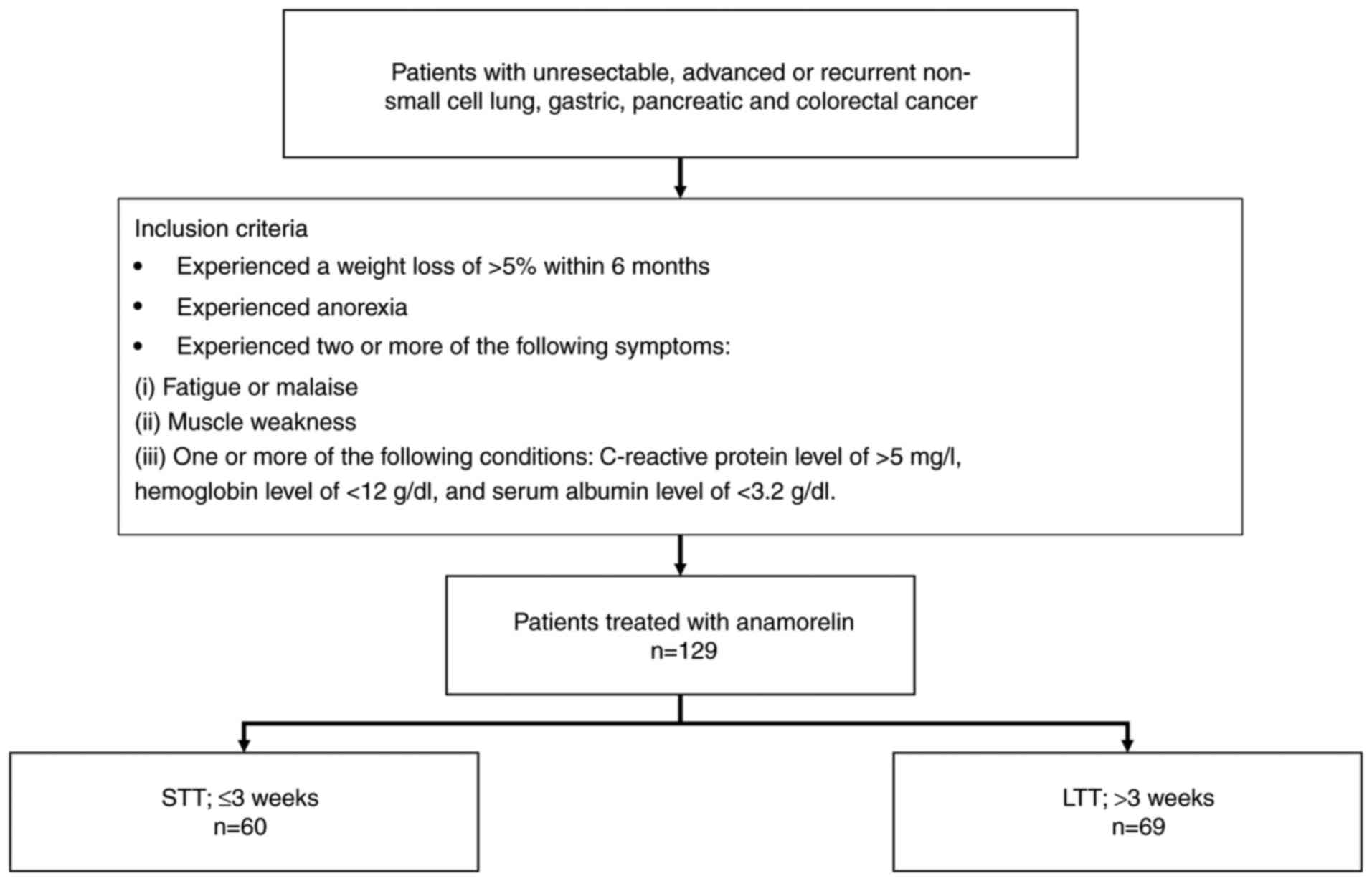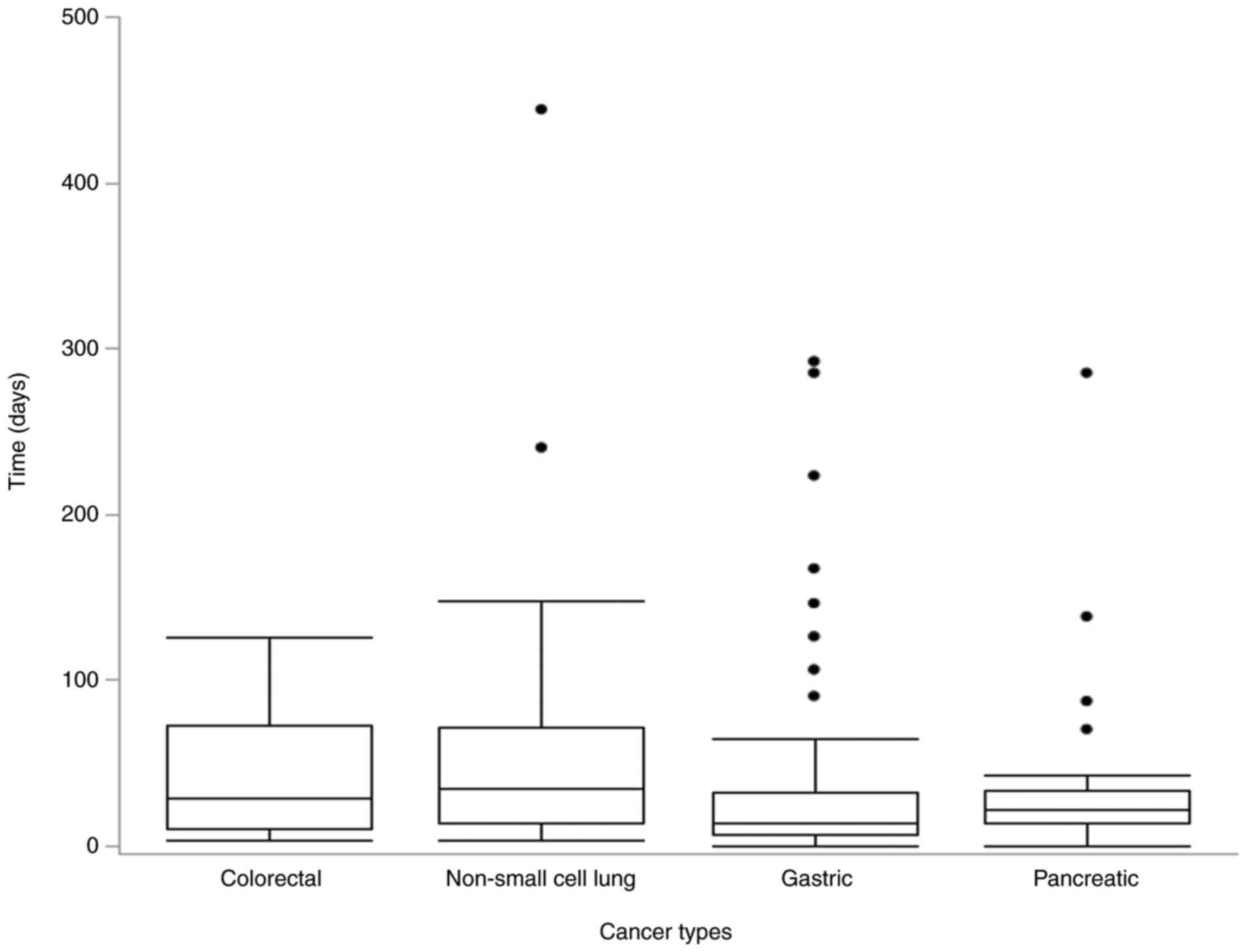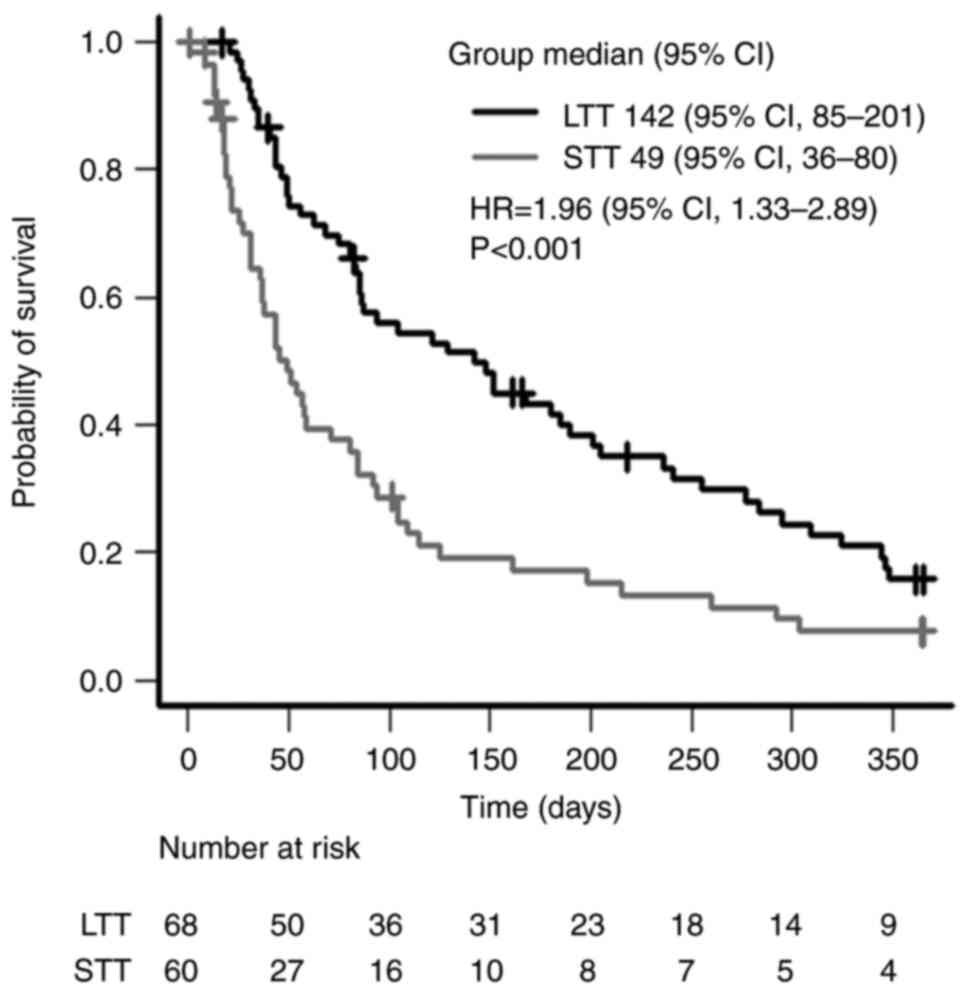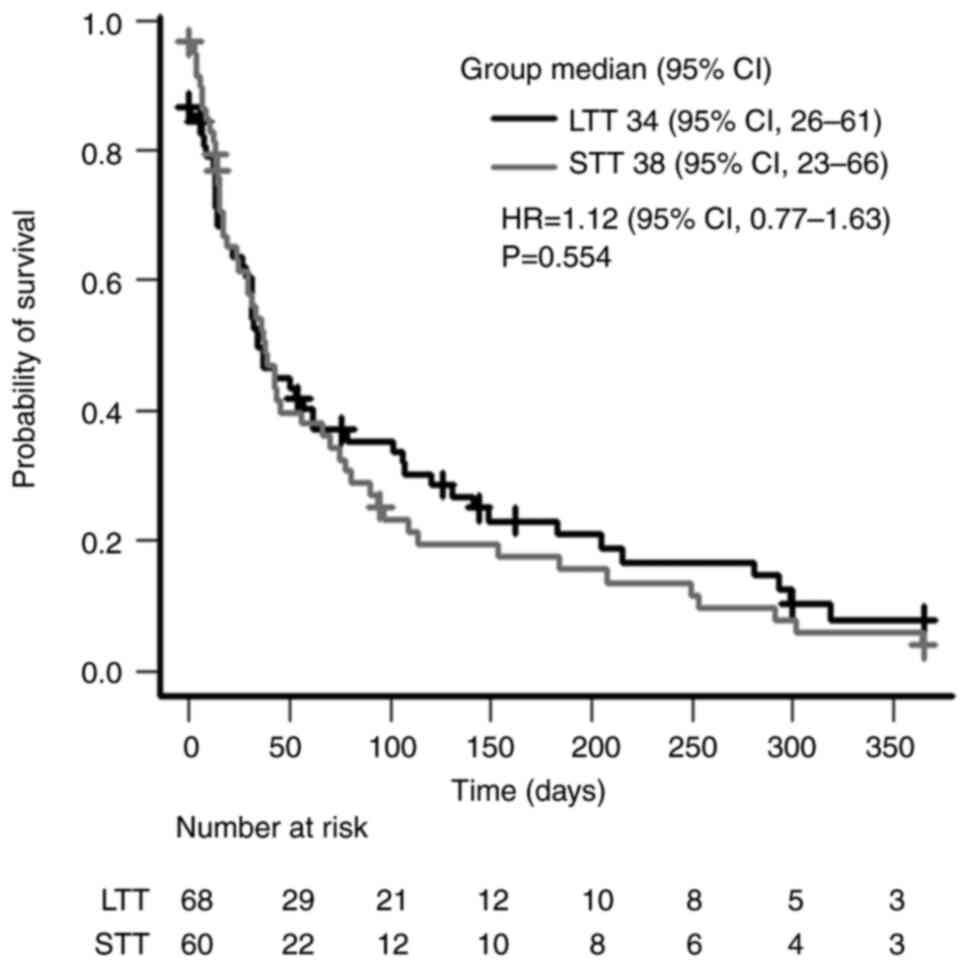|
1
|
Gullett N, Rossi P, Kucuk O and Johnstone
PAS: Cancer-induced cachexia: A guide for the oncologist. J Soc
Integr Oncol. 7:155–169. 2009.PubMed/NCBI
|
|
2
|
Argilés JM, Busquets S, Stemmler B and
López-Soriano FJ: Cancer cachexia: Understanding the molecular
basis. Nat Rev Cancer. 14:754–762. 2014.PubMed/NCBI View
Article : Google Scholar
|
|
3
|
Fearon K, Strasser F, Anker SD, Bosaeus I,
Bruera E, Fainsinger RL, Jatoi A, Loprinzi C, MacDonald N,
Mantovani G, et al: Definition and classification of cancer
cachexia: An international consensus. Lancet Oncol. 12:489–495.
2011.PubMed/NCBI View Article : Google Scholar
|
|
4
|
Arends J, Strasser F, Gonella S, Solheim
TS, Madeddu C, Ravasco P, Buonaccorso L, De Van Der Schueren MA,
Baldwin C, Chasen M, et al: Cancer cachexia in adult patients: ESMO
clinical practice guidelines*. ESMO Open. 6(100092)2021.PubMed/NCBI View Article : Google Scholar
|
|
5
|
Argilés JM, Moore-Carrasco R, Busquets S
and López-Soriano FJ: Catabolic mediators as targets for cancer
cachexia. Drug Discov Today. 8:838–844. 2003.PubMed/NCBI View Article : Google Scholar
|
|
6
|
Argilés JM, Busquets S and López-Soriano
FJ: Cytokines as mediators and targets for cancer cachexia. Cancer
Treat Res. 130:199–217. 2006.PubMed/NCBI View Article : Google Scholar
|
|
7
|
Japanese Society for Palliative Medicine:
Clinical guidelines for infusion therapy in advanced cancer
patients. KANEHARA & Co., Ltd., Tokyo, 2013.
|
|
8
|
Argilés JM, Busquets S and López-Soriano
FJ: Cancer cachexia, a clinical challenge. Curr Opin Oncol.
31:286–290. 2019.PubMed/NCBI View Article : Google Scholar
|
|
9
|
Nakanishi Y, Higuchi J, Honda N and Komura
N: Pharmacological profile and clinical efficacy of anamorelin HCl
(ADLUMIZ®Tablets), the first orally available drug for
cancer cachexia with ghrelin-like action in Japan. Nihon Yakurigaku
Zasshi. 156:370–381. 2021.PubMed/NCBI View Article : Google Scholar
|
|
10
|
Kojima M, Hosoda H, Date Y, Nakazato M,
Matsuo H and Kangawa K: Ghrelin is a growth-hormone-releasing
acylated peptide from stomach. Nature. 402:656–660. 1999.PubMed/NCBI View
Article : Google Scholar
|
|
11
|
Chen HY, Trumbauer ME, Chen AS, Weingarth
DT, Adams JR, Frazier EG, Shen Z, Marsh DJ, Feighner SD, Guan XM,
et al: Orexigenic action of peripheral ghrelin is mediated by
neuropeptide Y and agouti-related protein. Endocrinology.
145:2607–2612. 2004.PubMed/NCBI View Article : Google Scholar
|
|
12
|
Velloso CP: Regulation of muscle mass by
growth hormone and IGF-I. Br J Pharmacol. 154:557–568.
2008.PubMed/NCBI View Article : Google Scholar
|
|
13
|
Li WG, Gavrila D, Liu X, Wang L,
Gunnlaugsson S, Stoll LL, McCormick ML, Sigmund CD, Tang C and
Weintraub NL: Ghrelin inhibits proinflammatory responses and
nuclear factor-kappaB activation in human endothelial cells.
Circulation. 109:2221–2226. 2004.PubMed/NCBI View Article : Google Scholar
|
|
14
|
Chen JA, Splenser A, Guillory B, Luo J,
Mendiratta M, Belinova B, Halder T, Zhang G, Li YP and Garcia JM:
Ghrelin prevents tumour- and cisplatin-induced muscle wasting:
Characterization of multiple mechanisms involved. J Cachexia
Sarcopenia Muscle. 6:132–143. 2015.PubMed/NCBI View Article : Google Scholar
|
|
15
|
Wakabayashi H, Arai H and Inui A:
Anamorelin in Japanese patients with cancer cachexia: An update.
Curr Opin Support Palliat Care. 17:162–167. 2023.PubMed/NCBI View Article : Google Scholar
|
|
16
|
Naito T, Uchino J, Kojima T, Matano Y,
Minato K, Tanaka K, Mizukami T, Atagi S, Higashiguchi T, Muro K, et
al: A multicenter, open-label, single-arm study of anamorelin
(ONO-7643) in patients with cancer cachexia and low body mass
index. Cancer. 128:2025–2035. 2022.PubMed/NCBI View Article : Google Scholar
|
|
17
|
de Paula Pantano N, Paiva BSR, Hui D and
Paiva CE: Validation of the modified Glasgow prognostic score in
advanced cancer patients receiving palliative care. J Pain Symptom
Manage. 51:270–277. 2016.PubMed/NCBI View Article : Google Scholar
|
|
18
|
Kanda Y: Investigation of the freely
available easy-to-use software ‘EZR’ for medical statistics. Bone
Marrow Transplant. 48:452–458. 2013.PubMed/NCBI View Article : Google Scholar
|
|
19
|
Takeda T, Sasaki T, Okamoto T, Fukuda K,
Hirai T, Yamada M, Nakagawa H, Mie T, Furukawa T, Kasuga A, et al:
Efficacy of amamorelin in advanced pancreatic cancer patients with
a poor performance status. Intern Med. 64:351–358. 2025.PubMed/NCBI View Article : Google Scholar
|
|
20
|
Tsukiyama I, Iwata T, Takeuchi T, Kato RI,
Sakuma M, Tsukiyama S, Kato M, Ikeda Y, Ohashi W, Kubo A, et al:
Factors associated with early discontinuation of anamorelin in
patients with cancer-associated cachexia. Support Care Cancer.
31(621)2023.PubMed/NCBI View Article : Google Scholar
|
|
21
|
Yin Y and Zhang W: The role of ghrelin in
senescence: A mini-review. Gerontology. 62:155–162. 2016.PubMed/NCBI View Article : Google Scholar
|
|
22
|
Takiguchi S, Takata A, Murakami K,
Miyazaki Y, Yanagimoto Y, Kurokawa Y, Takahashi T, Mori M and Doki
Y: Clinical application of ghrelin administration for gastric
cancer patients undergoing gastrectomy. Gastric Cancer. 17:200–205.
2014.PubMed/NCBI View Article : Google Scholar
|
|
23
|
Ouyang X, Dang Y, Zhang F and Huang Q: Low
serum albumin correlates with poor survival in gastric cancer
patients. Clin Lab. 64:239–245. 2018.PubMed/NCBI View Article : Google Scholar
|
|
24
|
Takayama K, Kojima A, Honda C, Nakayama M,
Kanemata S, Endo T and Muro K: Real-world safety and effectiveness
of anamorelin for cancer cachexia: Interim analysis of
post-marketing surveillance in Japan. Cancer Med.
13(e7170)2024.PubMed/NCBI View Article : Google Scholar
|



















